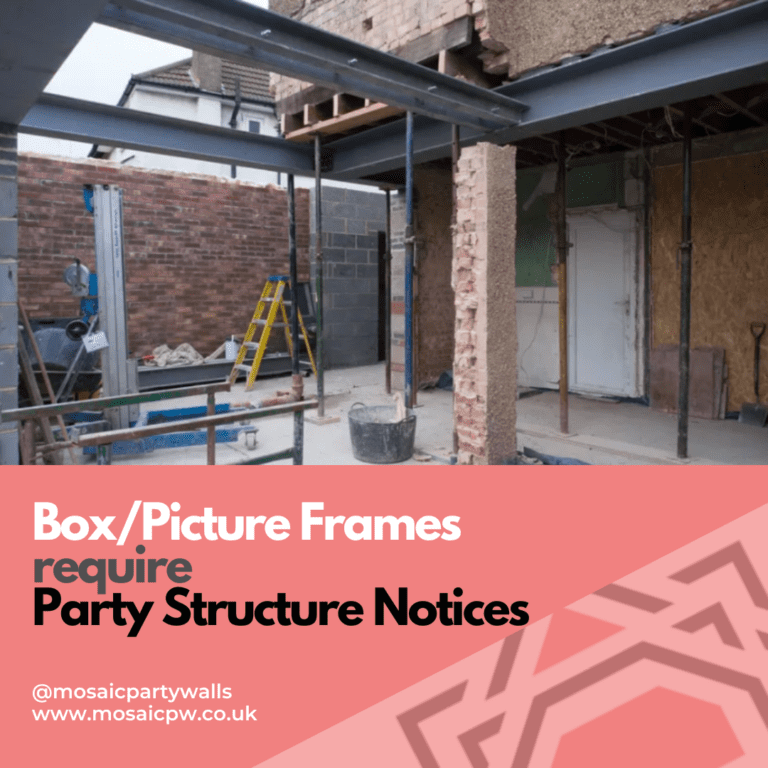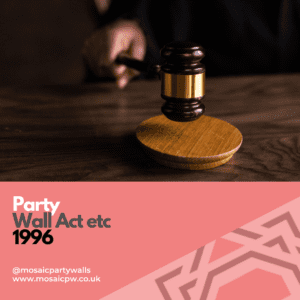Table of Contents
Introduction
Delving into creative projects like installing box frames, picture frames, or even goal posts is an exciting process for homeowners. However, the Party Wall Act 1996 adds a layer of responsibility to these seemingly straightforward projects. In this blog post, we will explore why the installation of such features requires the serving of relevant Party Wall Notices. Understanding the Party Wall Act is not just a legal necessity but a key element in ensuring a harmonious and legally compliant creative process.
Understanding the Party Wall Act
The Party Wall Act is a crucial legal framework designed to prevent and resolve disputes related to party walls, boundary walls, and various construction activities near neighbouring structures. When it comes to creative installations like box frames, picture frames, or goal posts, Section 2 of the Act becomes pertinent. This section outlines the need for serving Party Wall Notices when engaging in work that may affect the structural integrity of a shared wall. By understanding the provisions of this Act, homeowners can embark on creative projects with confidence, knowing they are fulfilling legal obligations and respecting the rights of their neighbours.
Navigating the Party Wall Act isn’t about stifling creativity; it’s about recognizing the shared responsibility for the structural elements that connect properties. This understanding is vital as it sets the stage for open communication and cooperative engagement with neighbours.
Why Do Box Frames Need Party Wall Notices
The installation of box frames, while seemingly minor, can have implications for the structural integrity of a party wall. Even if the work primarily concerns one property, the shared nature of the wall makes it subject to the Party Wall Act. Box frames may involve drilling, anchoring, or alterations to the wall structure, all of which can impact the neighboring property.
Serving
a Party Wall Notice in this context is not an obstruction to creative projects;
rather, it’s a proactive step to ensure transparency and communication with
adjoining owners. It provides neighbors with information about the planned
installation, allowing them to assess potential implications and voice any
concerns they may have. Acknowledging the shared responsibility for the party
wall’s stability is a fundamental aspect of navigating creative installations
under the Party Wall Act
Key Considerations
1. Structural Impact Assessment: Before installing box frames or similar features, conduct a structural impact assessment. Understand how the installation might affect the party wall and neighbouring property. This assessment informs decision-making and communication with neighbours.
2. Professional Advice: Seek professional advice, particularly from a party wall surveyor or structural engineer. Their expertise can guide you in serving
accurate and comprehensive Party Wall Notices, ensuring legal compliance and addressing potential concerns.
3. Notification Timelines: Be mindful of the timelines involved in serving Party Wall Notices. Timely communication provides neighbours with sufficient notice and contributes to a smoother construction process, fostering positive relations.
4. Mitigation Measures: Consider and communicate any measures taken to mitigate potential disruption or inconvenience to neighbours during the installation. This proactive approach demonstrates a commitment to neighbourly relations.
5. Documentation: Maintain clear documentation of the structural impact assessment, professional advice received, and any correspondence with neighbours. Documentation not only ensures a transparent and legally sound process but also serves as a record of responsible construction practices.
Neighbour Consideration
Undertaking creative installations, even on a small scale, is an opportunity to consider and engage with neighbours. While legal requirements mandate the serving of Party Wall Notices, the neighbour consideration goes beyond compliance. Engaging with neighbours, explaining the necessity of the installation, and addressing any concerns they might have contribute to a positive environment.
Creative projects have the potential to enhance the aesthetic appeal of a property, but they also have the potential to cause concern among neighbors. Proactive communication allows for collaborative decision-making and establishes a foundation for positive post-installation relations. Neighbor consideration isn’t just about legal obligations; it’s about fostering community-minded construction practices.
Legal Requirement
Section 2 of the Party Wall Act specifically addresses the legal requirement for serving Party Wall Notices when undertaking work that may affect the structural integrity of a shared wall. This formal notification serves as a means of acknowledging the shared responsibility for the party wall. Legal compliance is not a hindrance to creativity; rather, it ensures that neighbors are informed and have the opportunity to voice concerns or provide consent. It is a proactive step towards preventing disputes and fostering positive neighbour relations during and after the installation.
Adhering to the legal requirement ensures that creative projects proceed in a transparent and legally sound manner. It sets the stage for a collaborative environment where legal obligations are met with an understanding of the impact on neighbouring properties.
Closing Remarks
In conclusion, creative installations like box frames, picture frames, or goal posts can be delightful additions to a property. Navigating these projects under the Party Wall Act isn’t about restricting creativity; it’s about fostering responsible construction practices and positive neighbour relations. By approaching these installations with an understanding of legal obligations, key considerations, and a neighbour-focused approach, homeowners not only fulfil their responsibilities but also contribute to a vibrant and harmonious community.
Need more advice – book a free 15min advice session or have a read of our FAQ.



